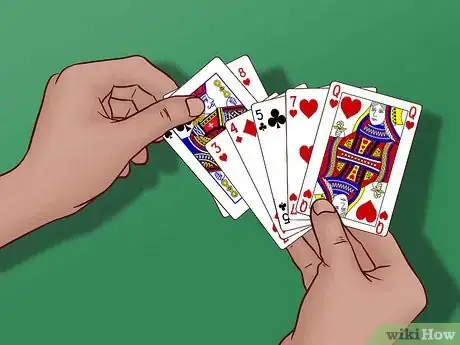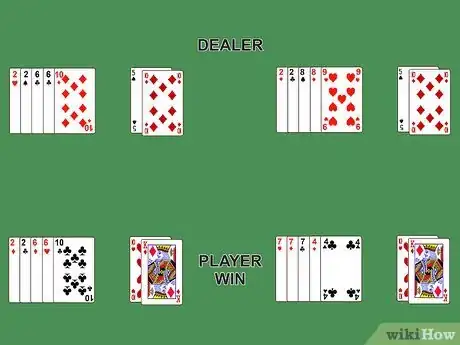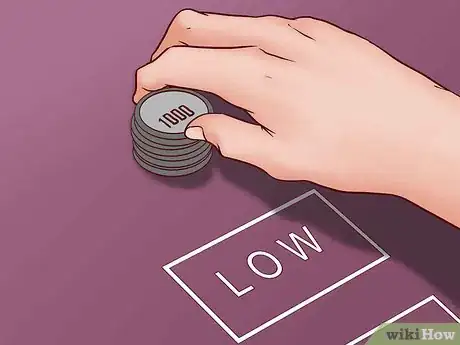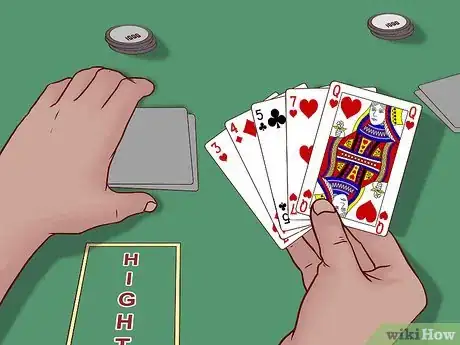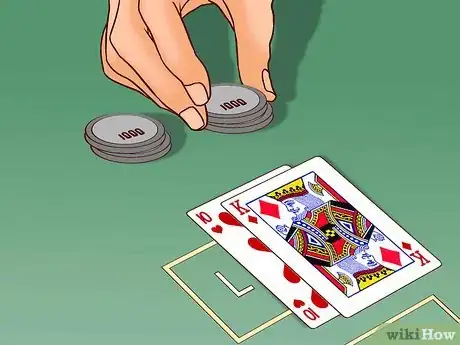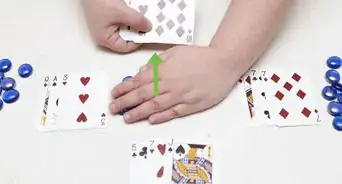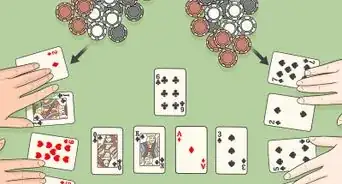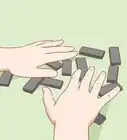This article was co-authored by wikiHow Staff. Our trained team of editors and researchers validate articles for accuracy and comprehensiveness. wikiHow's Content Management Team carefully monitors the work from our editorial staff to ensure that each article is backed by trusted research and meets our high quality standards.
This article has been viewed 25,352 times.
Learn more...
Pai Gow Poker is a card variation of the Chinese domino game called Pai Gow. It's an exciting but relaxed casino game that has become extremely popular. Playing Pai Gow Poker is actually really easy to learn. With a basic understanding of the 5-card hands associated with traditional poker and a few simple rules, you'll be playing Pai Gow Poker in no time!
Steps
Learning the Basics
-
1Learn the 10 basic 5-card hands in traditional poker. Pai Gow Poker is a variation of poker that uses the traditional 5-card hand. However, instead of playing against the other players at the table, everyone is playing against the dealer's hand. Before you play Pai Gow Poker, you need to familiarize yourself with the basic 5-card poker hands.[1]
- Royal flush: Ace, King, Queen, Jack, and a 10 of the same suit.
- Straight flush: 5 consecutive cards of the same suit like ace, 3, 4, 5, and 6 of clubs.
- 4 of a kind: 4 of the same cards, but different suits.
- Full house: 3 cards of the same ran plus 2 cards of the same rank.
- Flush: 5 cards of the same suit.
- Straight: 5 cards in sequence but can be from different suits, like 4, 5, 6, 7, 8.
- 3 of a kind: 3 of the same cards.
- 2 pair: 2 matching cards of the same ranking and 2 matching cards of another rank.
- A pair: 2 matching cards.
- High card: the highest ranking card in the hand.
-
2Make your best 2 hands out of the cards you're dealt each round. In Pai Gow poker, you're dealt 7 cards each round. Once you get your cards, you need to arrange your best 5-card hand and your best 2-card hand. Your 5-card hand has to be better than your 2-card hand. For your 2-card hand, the best you can get is a pair.[2]
- Not every one of the 5 cards needs to be a part of your hand. For example, if you have 3 of a kind, the remaining 2 cards can simply form the rest of your 5-card hand.
Advertisement -
3Try to beat both of the dealer's hands to win a round. In Pai Gow poker, you play against the dealer, not the other players at the table. If both your 5-card hand and your 2-card hand beats the dealer, you win the round and double the bet that you placed. Lose both of your hands against the dealer's hands, then you lose your bet. If you win 1 of your hands and the dealer wins the other, then the round ends in a push and nobody wins the round.[3]
- If both of your hands tie the dealer, then the dealer wins that round.
Playing a Round
-
1Choose the dealer for each round. If you are not playing at a casino, you can take turns being the dealer or “banker.” The goal of Pai Gow Poker is to defeat the dealer, not the other players at the table. You can change the dealer after each round to keep the play interesting.[4]
-
2Place your bet before you get your hand. Every player at the table must place their bets before the dealer will deal out 7 cards to each player. There will be a minimum bet and a maximum bet and you need to place your bet between those amounts.[5]
Tip: Some tables at casinos will have different minimum and maximum amounts, so choose a table that you are comfortable playing.
-
3Wait for the dealer to pass out 7 cards to each player. After the initial bet, the dealer will deal 7 cards to each player at the table and each player will begin to form their 2 hands. Then the dealer will deal themselves 7 cards, face up and arrange their hands. You'll take a look through the 7 cards you were dealt and form them into 2 hands, which you will place face-up on the table.[6]
- Every player, including the dealer, will be able to see everyone's hands at the table.
-
4Form your 5-card hand and your 2-card hand. Look through your cards and form your 5-card hand with your best cards and your 2-card hand with the best cards that you have left.
- Remember, your 5-card hand must be better than your 2-card hand.[7]
Scoring in a Round
-
1Compare your 2-card hand to the dealer's 2-card hand. After everyone at the table has arranged their 2 hands, the dealer will deal their 7 cards and form their 5-card and 2-card hands. Compare your 2-card hand to the dealer's hand to see if yours is better.[8]
- If you have a pair and they have a pair, the higher pair wins.
Tip: The highest card of one hand beats the highest card of the other hand if there are no pairs. If the 2 highest numbers match, then the highest number of the second card wins. For example, if you have a 10 and a 4 and the dealer has a 10 and a 3, then your 4 beats their 3, so you win the hand.
-
2Match your 5-card hand against the dealer's 5-card hand. You only need to beat the dealer's hand to win that round, so after you've compared your 2-card hand to theirs, check their 5-card hand to see how it stacks up next to yours. Remember the 10 basic 5-card hands and check to see if your hand outranks the dealer's hand.[9]
- If your hand ties the dealer's hand, then the dealer wins that hand.
-
3Win the round by defeating both of the dealer's hands. If both of your hands defeat the dealer's hands, then you will receive double the amount that you bet. If you lose both of your hands against the dealer's hands, then the dealer will collect your bet and add it to the bank.[10]
- Gambling can be extremely addictive. Limit your betting to a healthy amount.
-
4Score a push to move on to the next round. If you win 1 of your hands and the dealer wins the other, then the round ends in a push, or a tie. That means that nobody wins and the play moves on to the next round.[11]
- For example, if your 5-card hand beats the dealer's 5-card hand, but your 2-card hand is defeated by the dealer's 2-card hand, then the round ends in a push.
Warnings
- Gambling can be highly addictive. If you or someone you know has a gambling problem, try going to a Gambler's Anonymous meeting. If you are in the United States, call the national helpline at 1-800-522-4700.⧼thumbs_response⧽
References
- ↑ https://wizardofodds.com/games/pai-gow-poker/
- ↑ https://www.sandiegouniontribune.com/entertainment/casinos/sd-et-casinos-paigow-20171203-story.html
- ↑ https://www.sandiegouniontribune.com/entertainment/casinos/sd-et-casinos-paigow-20171203-story.html
- ↑ https://wizardofodds.com/games/pai-gow-poker/
- ↑ https://www.sandiegouniontribune.com/entertainment/casinos/sd-et-casinos-paigow-20171203-story.html
- ↑ https://www.sandiegouniontribune.com/entertainment/casinos/sd-et-casinos-paigow-20171203-story.html
- ↑ https://www.pagat.com/partition/paigowp.html
- ↑ https://www.pagat.com/partition/paigowp.html
- ↑ https://wizardofodds.com/games/pai-gow-poker/

